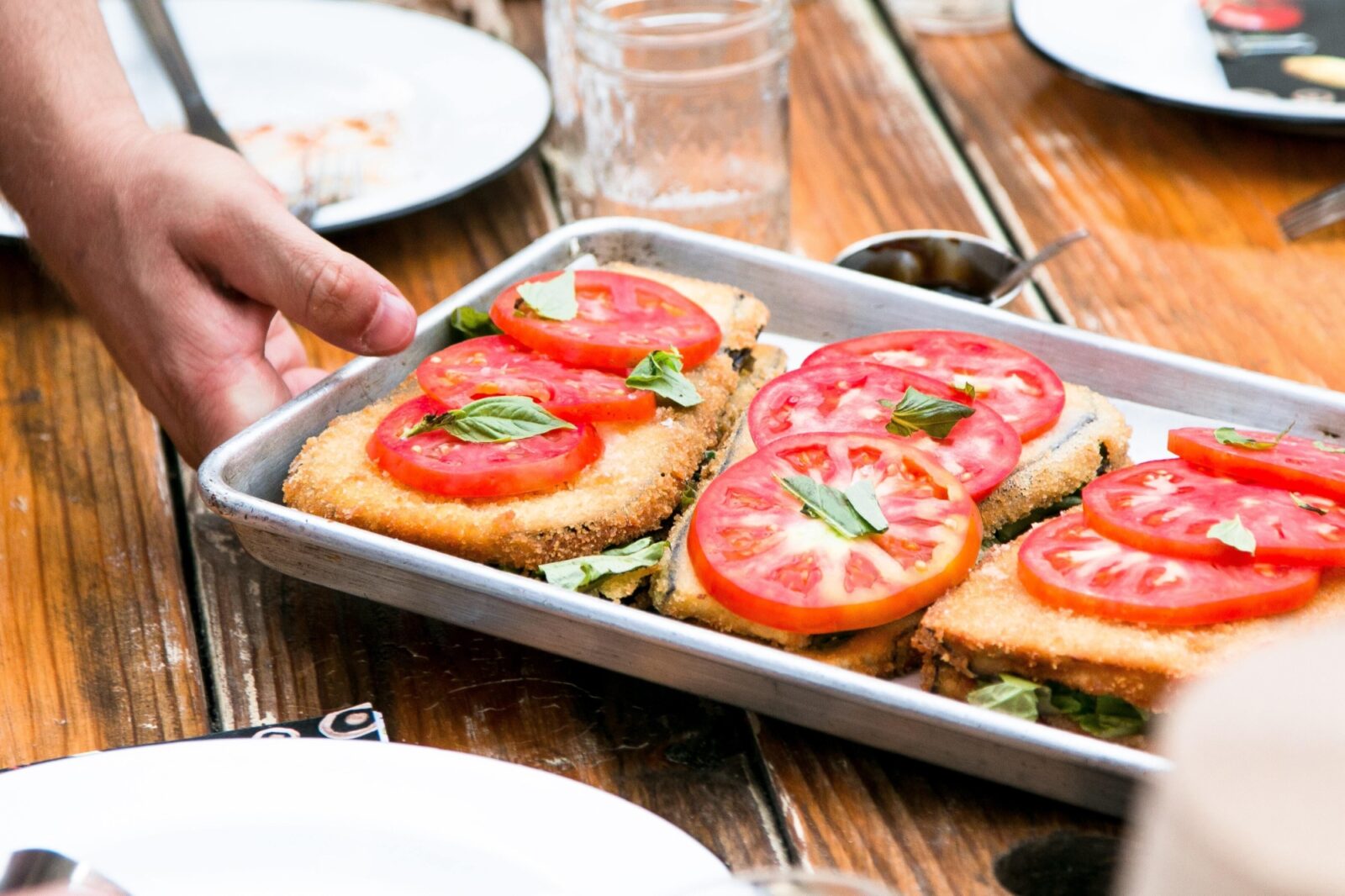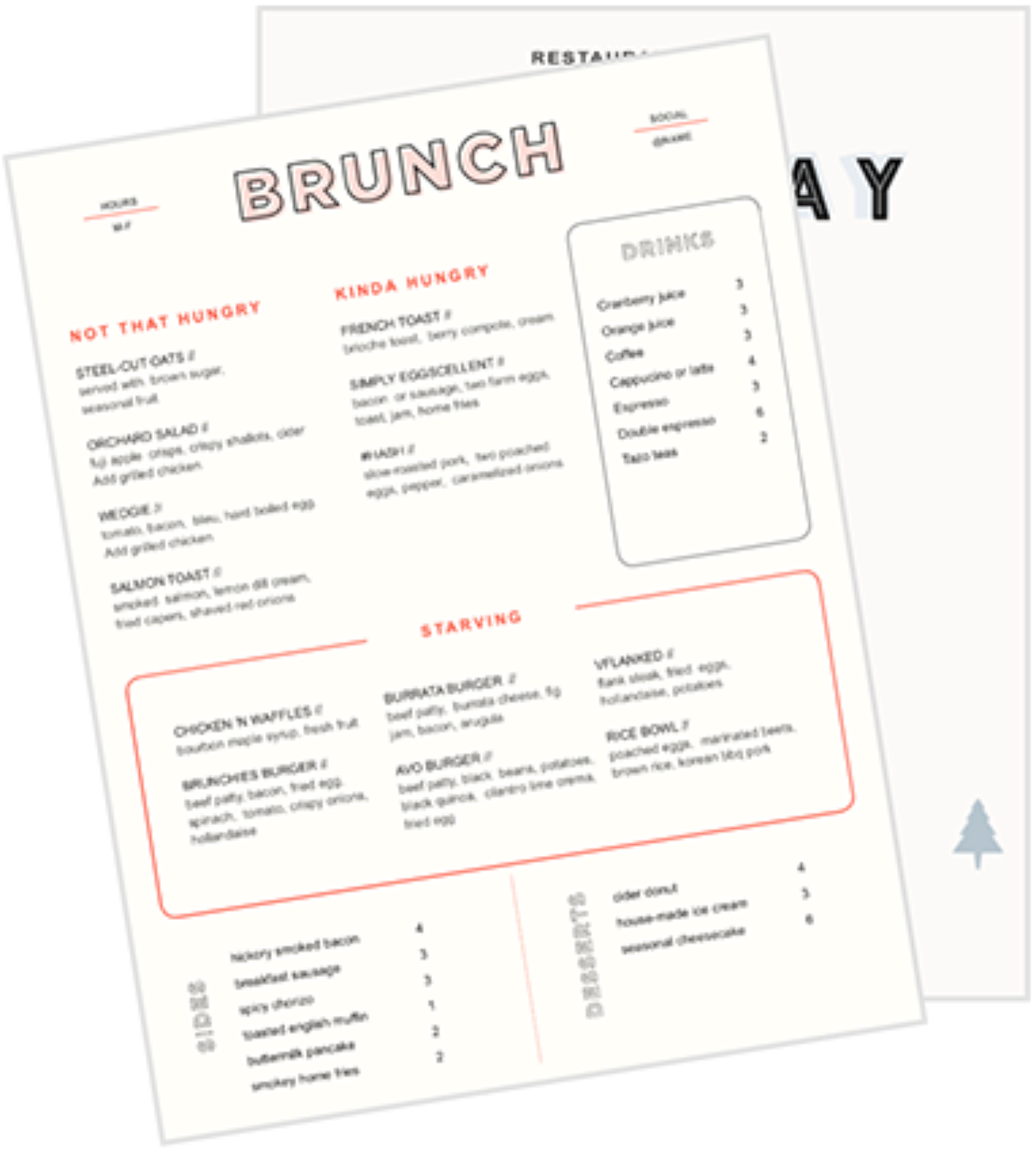
How to Improve Your Sales With A Seasonal Menu
Learn what a seasonal menu is, how a summer menu can improve business, and how to make a summer menu that will keep customers coming back.

Tessa ZuluagaAuthor


Restaurant Menu Templates
Use these menu templates as a starting point for your menu design or to give your menus a refresh.
Get free downloadIt’s advised that restaurants update their menus around 4 times a year, and there’s a good reason they do so. According to Grubhub, seasonal menus are linked to a 26% increase in orders from diners. A seasonal change is the perfect excuse to freshen your menu up.
Summer, for example, is the busiest time of year for most restaurants. A seasonal menu is a good way to capitalize on in-season ingredients, offer something new to loyal customers, and excite new customers with seasonal dishes and farm-to-table menu items.
In this article, you’ll learn what a seasonal menu is, how it can improve business, and how to craft one that will keep customers coming back.
Restaurant Menu Templates
Use these menu templates as a starting point for your menu design or to give your menus a refresh.

What is a seasonal menu?
A seasonal menu is one that is available only during certain seasons, like summer or fall. These menus typically feature in-season ingredients from local farms and local producers, with seasonal flavors. For instance, a summer menu may have seasonal ingredients like watermelon and corn on the cob, while a fall menu may have soups, brussels sprouts, and sweet potatoes. This way, your dishes contain the best flavors of the season.
Often, restaurants offer a summer menu in conjunction with opening a patio or rooftop, allowing diners to enjoy a seasonal dining experience. After all, 54% of diners are more likely to choose a restaurant with outdoor seating. Take a look at our 20 Best Outdoor Dining Restaurants to discover patio and rooftop inspiration.
What are the benefits of a seasonal menu?
There are many benefits to a seasonal menu. First, featuring in-season ingredients ensures your seasonal dishes and flavors are fresh. Sourcing a farm-to-table menu from local farms and producers demonstrates a commitment to the community while also improving menu quality — two things customers love.
Seasonal menus may also be more environmentally- and cost-friendly, as you won’t have to pay more to source out-of-season ingredients from faraway places. According to the latest research from Datassential, 90% of consumers say sustainability, in general, matters to them. This is especially true for Gen Z diners, who ranked natural, organic, and sustainable items as highly important.
Seasonal foods help keep food costs down while offering dishes that diners crave at specific times of the year. Combined with sustainability efforts, a seasonal menu can help you provide a better-tailored dining experience for your loyal customers to keep them coming back and spreading the word about your new menu.
How do you make a seasonal menu?
Making your core menu is hard enough, so how do you add a seasonal menu into the mix? There’s a lot to think about when making a menu, from pricing and margins to accessibility and figuring out your menu design.
To help you out, we’ve created a guide to improving your menu ideas to have the best seasonal menu, every time.
Use in-season ingredients
Sourcing from local farms and producers is one of the hottest trends in the restaurant industry for a good reason. And why not? A local farm-to-table experience brings the freshest, in-season ingredients in the shortest distance possible to land on diners’ plates. Why buy cucumbers from another state when you can support your local community? These ingredients taste better, the process is better for the planet, and they provide inspiration for your chefs to create new dishes out of seasonal produce and flavors.
If you’re not sure what to put on seasonal menu, take inspiration from the seasonal foods that are being harvested and produced in your area.
Revisit your inventory and suppliers
Related to the previous point, if you aren’t using local producers, consider an audit of your inventory and suppliers. Maybe the kitchen has a surplus of a staple like flour, or a brioche french toast special left a ton of powdered sugar unused. Then perhaps New Orleans-style beignets make sense on your summer menu!
Making a menu depends on what’s available and how much it costs. Taking the time to assess your inventory and local supplier costs will help you figure out what seasonal dishes may yield the biggest profit. Tools like xtraChef by Toast make cost analysis easier than ever for restaurant owners and managers.
Evaluate your menu prices
Technology is a huge asset for restaurants, especially when planning a seasonal menu. With xtraChef, you can easily figure out profit margins and procure sales data to find the best price for seasonal dishes.
With rising food costs, it’s important to find ways to save money and improve your bottom line. Implementing the right menu pricing strategies by utilizing data will help you find the
right balance between being attractive to customers and profitable for the restaurant. Since in-season ingredients tend to be less expensive than out-of-season ones, a simple cost breakdown and menu pricing analysis could justify keeping one dish on a new summer menu and leaving another off.
Use menu engineering
Believe it or not, the way your menu looks can make a difference to your customers. The average customer spends 109 seconds looking at a menu, and you want to make sure that time is worthwhile.
Menu engineering is the process of balancing your menu between popularity and profitability. When creating a summer menu, menu engineering can help you control costs, and maximize profit, while elevating your restaurant’s brand. One study found that ongoing menu engineering can increase restaurant profits by 10-15%.
After all, a menu is one of the principal ways a customer engages with your restaurant. You want the menu to showcase restaurant values and play up the use of local, in-season ingredients to lean into the summer vibes. People have a lot of options for where to eat; make your vibes immaculate.
Use a menu template
While menu engineering is important for designing and maximizing the profitability of your summer menu, a menu template is essential for maintaining your brand throughout restaurant seasonality. Branding shouldn’t change dramatically from season to season and a menu template helps you update your menu quickly without needing to hire a designer.
Once you’ve figured out the new dishes for your new menu — regardless of season — a menu template lets you make quick updates and roll out new menus. Whether you print your menu or host it online, a menu template is a time-saving and cost-saving asset.
Menu Engineering Course
Take this course to make the most of your menu. Learn about menu psychology and design, managing your menu online, and adapting your menu to increase sales.

Update your drink menu
Mai tais, pina coladas, daiquiris, oh my! Who doesn’t love a tropical drink or two in the summer? In fact, during the 4th of July weekend rum sales increase by 92%! If you’re sourcing local, in-season ingredients for your entrees, don’t forget to give the drink menu some love, too.
Without data to verify the claim, it seems reasonable that many people are more likely to crave a summer cocktail over a specific summer dish. As such, your summer menu should feature specialty cocktails, wine, and beer that reflect the season. If the breweries and wineries you typically source from create seasonal options, you should offer them on your restaurant menu.
Promote on social media
You should promote your restaurant on social media throughout the year, but a new menu or seasonal changes are great opportunities to increase engagement and attract new customers.
Social media can be a game changer for businesses, especially when introducing new items or making seasonal menu changes. Leveraging platforms like Instagram, TikTok, Facebook, and Twitter will keep loyal customers excited to come back and draw the interest of new customers.
Don’t know where to start? Check out our social media marketing guide.
Ask for (and incorporate!) feedback
Customers are the lifeblood of any business. You want to know what they like and what they don’t, which is why getting guest feedback is so important.
After introducing a summer menu, gathering guest feedback will help you make improvements throughout the season. That last bit is crucial. Don’t just gather feedback — actually incorporate it into future menu iterations! Whether guests aren’t crazy about a particular dish or they feel like something is missing from the menu, feedback is a great way to set your summer menu and future seasonal menus up for success. Check out this Free Restaurant Survey Template to gather feedback more easily.
Restaurant Survey Template
Use this template to ask your guests about their experiences in your restaurant. These survey questions will give you the data you need to make informed changes and improve the overall dining experience.

Summer menu ideas for your seasonal menu
Sometimes, the best inspiration comes from competitors. So, to get you started, we’ve outlined a number of summer menu ideas below from these delicious restaurants.
Oysters on The Half Shell from Eventide Oyster Co. in Portland, ME - Eventide offers several different types of oysters, divided into two categories, “From Maine” and “From Away,” presented over ice for your viewing pleasure. Both traditional and unique accouterments include cocktail sauce, red wine mignonette, tabasco ice, kimchi ice, pickled red onion ice, and horseradish ice.
Peking inspired whole roasted duck from The Nautilus in Nantucket, MA - For those larger parties, The Nautilus offers this “Table Feast” peking inspired whole roasted duck. This incredible offering must be ordered at the beginning of a meal so the kitchen has enough time to craft it just right. It includes oven-roasted breast, crispy confit leg, warm steamed buns, ginger scallion rice, herbs, pickles hoisin, house smoky mayo, sriracha — yes, please!
Grilled halibut from L’Oursin in Seattle, WA - This gluten-free dish is worth the hype! The fletan au grill includes grilled halibut in nettle marinière with mussels and fennel. Nettle season is generally considered to be early spring through fall, but the best time to harvest them is in the spring before they flower. A delicious flavor for the season!
Tuna poke from The Longboard in Sullivan’s Island, SC - There’s nothing better in the summertime than some fresh poke! The Longboard offers a variety of poke bowls but their tuna bowl is particularly a fan-favorite. This dish includes Yellowfin tuna, cucumber, arare, radish, sambal aioli, sesame, scallions, and rice crisp 😋.
Ceviche from Celeste in Somerville, MA - When done right, ceviche can be one of the most refreshing, delicious appetizers, and Celeste does it right. This restaurant doesn’t just serve one type of ceviche, but four. Dine out at Celeste to try ceviche de blue cod, mixed fish ceviche, palm and artichoke hearts ceviche, and ceviche de shrimp & mango with maracuya infusion.
Shrimp cocktail from Le Bilboquet in Atlanta, GA - Something about fresh seafood screams, “it’s summertime!”, and Le Bilboquet knows it. This restaurant has a beautifully crafted menu, but a staple here has to be their shrimp cocktail. It’s simple, four Gulf Shrimp and cocktail sauce but it never disappoints.
Kale caesar salad from Malibu Farm Restaurant in Malibu, CA - There’s truly no better meal than a crisp caesar salad with an ice cold beverage, and Malibu Farm Restaurant is serving up both. The kale caesar salad here also includes delicious seasonal vegetables! It features zucchini, roasted chickpeas, parmesan, romaine, and kale — it’s the perfect summer lunch!
Avocado toast from Cindy’s in Chicago, IL - Avocado toast has become a popular brunch item and Cindy’s is especially delicious. Featuring Ramp Pistou, Parmigiano, Pea Shoots, Pickled Fresno & Cippolini, Tomato, and Toasted Sourdough this dish is surely a hit every time.
Little neck clams from Moby’s in East Hampton, NY - The more seafood the better! Moby’s offers many options on their raw bar and we recommend the little neck clams. These are served with cocktail sauce and lemon which pair perfectly with a glass of white wine on a summer day.
Papaya salad from Ema in Houston, TX - Salads are great, but uniquely crafted salads are even better. The papaya salad from Ema is a flavorful, beautiful dish. This salad features sweet papaya, plain yogurt, orange segments, agave lime dressing, and housemade granola. It’s sweet with some soft acidity and super refreshing. Pair it with an iced oat matcha.
Set your restaurant up for success, every season
According to a 2022 study, 68% of diners rank food quality as the most important factor when deciding where to dine. Creating seasonal menus is a great way to ensure your food is fresh, in-season, and sourced from local farms and producers. When creating a summer menu, reference this guide to design menu items that feature seasonal flavors that will keep loyal customers coming back and profit margins that will raise your bottom line.
Is this article helpful?
DISCLAIMER: This information is provided for general informational purposes only, and publication does not constitute an endorsement. Toast does not warrant the accuracy or completeness of any information, text, graphics, links, or other items contained within this content. Toast does not guarantee you will achieve any specific results if you follow any advice herein. It may be advisable for you to consult with a professional such as a lawyer, accountant, or business advisor for advice specific to your situation.
Read More
Subscribe to On the Line
Sign up to get industry intel, advice, tools, and honest takes from real people tackling their restaurants’ greatest challenges.



